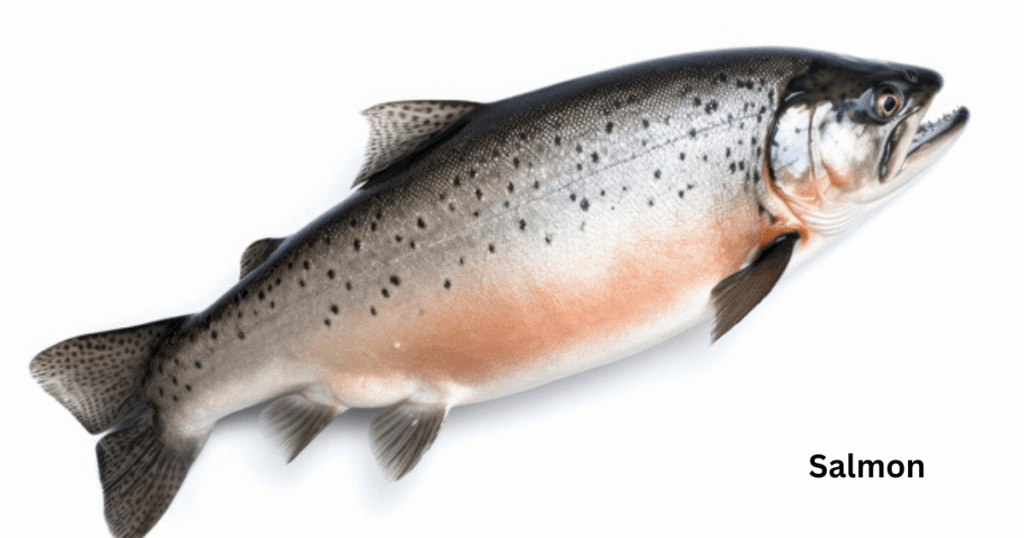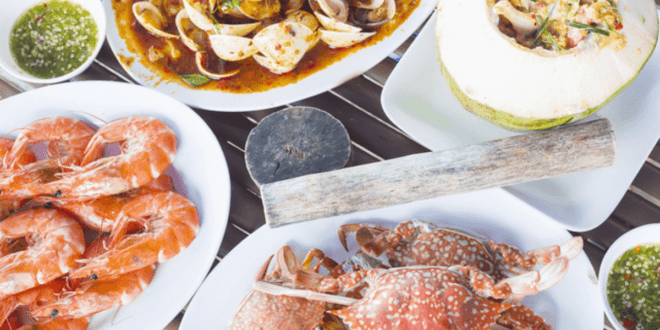In the quest for weight loss and overall well-being, the role of diet plays a pivotal part. One food group that has gained significant attention in this pursuit is seafood. Seafood, known for its rich nutrient content and health benefits, has become a popular choice among individuals aiming to achieve weight loss goals. In this introduction, we will delve into the significance of incorporating seafood into a healthy diet plan for effective weight management. Let’s explore how seafood can be a valuable asset in the journey towards a healthier and slimmer lifestyle.

Benefits of Seafood for Weight Loss
High Protein Content
– Seafood is a rich source of high-quality protein, which is essential for weight loss.
– helps in reducing appetite, boosting metabolism, and preserving lean muscle mass during weight loss.
– Incorporating seafood into a diet can aid in feeling full and satisfied, leading to reduced calorie intake and promoting weight loss.
Omega-3 Fatty Acids
– Seafoods, such as salmon and mackerel, are packed with beneficial omega-3 fatty acids.
– Omega-3s play a crucial role in promoting metabolism and reducing inflammation in the body.
– By including seafood rich in omega-3s in your diet, you can potentially enhance your weight loss efforts and support overall health.
Low in Calories and Saturated Fats
– Seafood tends to be lower in calories and saturated fats compared to other protein sources like red meat.
– Choosing seafood as a protein option can help in reducing overall calorie intake without compromising on essential nutrients.
– The low saturated fat content in seafood makes it a healthier choice for weight loss, as excessive saturated fat consumption can hinder weight loss goals and pose health risks.
Types of Seafood Ideal for Weight Loss
1. Salmon

- Rich in Omega-3s and Protein: Salmon is a nutritional powerhouse, packed with heart-healthy omega-3 fatty acids and high-quality protein.
- Weight Loss Benefits: Its protein content helps in promoting satiety, while the omega-3s support metabolism and reduce inflammation, making it an ideal choice for individuals aiming to lose weight.
2. Tuna

- Low in Calories and High in Protein: Tuna is a low-calorie seafood option that is also an excellent source of high-quality protein.
- Weight Management Benefits: Its low-calorie nature makes it a favorable choice for weight-conscious individuals, while its protein content supports muscle maintenance and helps in controlling appetite.
3. Shrimp

- Low in Fat and High in Protein: Shrimp is a seafood option that is low in fat and calories making it a suitable choice for weight management.
- Weight Loss Support: Its high protein content aids in promoting satiety and muscle maintenance, while being low in fat makes it an ideal addition to a weight loss-focused diet plan.
Nutritional Value of Seafood

Vitamins and Minerals in Seafood
– Omega-3 Fatty Acids: Found in fatty fish such as salmon, mackerel, and sardines, omega-3s are essential for heart health, brain function, and reducing inflammation.
– Vitamin D: Many seafood varieties are excellent sources of vitamin D, crucial for bone health, immune function, and overall well-being.
– B Vitamins: Seafood contains various B vitamins like B12, important for nerve function and energy metabolism.
– Iron and Zinc: Certain seafood, such as shellfish, are rich in iron and zinc, essential for immunity and overall health.
Importance of Variety in Seafood Consumption
– Different seafood varieties provide a diverse array of nutrients.
– Consuming a variety of seafood ensures a broader intake of essential vitamins and minerals, promoting overall health and well-being.
– Incorporating different types of seafood in the diet also reduces the risk of overexposure to specific contaminants that may be present in certain seafood varieties.

Incorporating Seafood into a Weight Loss Diet
Incorporating seafood into a weight-loss diet offers a variety of options for delicious and nutritious meals. Below are some tips on how to include in daily meals and healthy cooking methods to retain its nutritional value.
Incorporating Seafood into Daily Meals
Grilled or Baked Fish: Opt for grilled or baked fish as a protein source in main dishes. Season with herbs and citrus for added flavor without excess fat and calories.
Seafood Salads: Create refreshing salads with shrimp, crab, or tuna as the central protein element. Combine with vibrant vegetables and a light vinaigrette for a satisfying loworie meal.
Seafood Wraps or Tacos: Utilize seafood in wraps or tacos with whole grain tortillas or lettuce wraps. Incorporate fresh vegetables and a light yogurt-based sauce for a healthy and vibrant meal.
Healthy Cooking Methods for Seafood
Steaming: Use the steaming method to cook seafood, preserving its natural flavors and nutrients without adding excess fats or oils.
Poaching: Poaching seafood in a flavorful broth can infuse the protein with enticing tastes while maintaining its nutritional value.
Grilling or Broiling: Grilling or broiling seafood with minimal oil can enhance its flavor while creating a nutritious and low-calorie dish.
Avoid Deep Frying: Minimize or avoid deep-frying seafood, as this cooking method can significantly increase the calorie content and compromise its nutritional benefits.
By incorporating these strategies, individuals can enjoy the health benefits of seafood while maintaining a weight loss-focused diet, without sacrificing flavor or nutritional value.

Seafood Recipes for Weight Loss
Certainly! Here are some easy and healthy seafood recipes suitable for weight loss, including meal ideas for breakfast, lunch, and dinner:
Breakfast
Smoked Salmon and Avocado Breakfast Toast
- Whole grain bread
- Smoked salmon
- Sliced avocado
- Fresh dill
- Lemon juice
- Salt and pepper
Instructions
1. Toast the whole grain bread to your desired level of crispness.
2. Spread the sliced avocado on the toast.
3. Layer the smoked salmon on top of the avocado.
4. Drizzle with a bit of lemon juice and sprinkle a pinch of salt and pepper for flavor.
5. Garnish with fresh dill.
Lunch
Tuna Salad Lettuce Wraps
- Canned tuna
- Diced celery
- Diced red onion
- Greek yogurt
- Dijon mustard
- Lemon juice
- Salt and pepper
- Lettuce leaves
Instructions:
1. In a bowl, mix the canned tuna, diced celery, and red onion.
2. In a separate bowl, combine Greek yogurt, Dijon mustard, lemon juice, salt, and pepper to create a dressing.
3. Toss the tuna mixture with the dressing.
4. Spoon the tuna salad onto lettuce leaves and wrap them to form lettuce wraps.
Dinner
Grilled Lemon Herb Cod
- Cod fillets
- Lemon zest
- Chopped fresh herbs (such as parsley, dill, or chives)
- Olive oil
- Salt and pepper
Instructions:
1. Preheat a grill or grill pan to medium-high heat.
2. In bowl, mix lemon zest, chopped herbs, olive oil, salt, and pepper to create a marinade.
3. Brush the cod fillets with the marinade.
4. Grill the cod fillets for 3-4 minutes on each side, or until the fish is cooked through and has grill marks.
These recipes are not only delicious but are also packed with nutrients and are lower in calories, making them ideal for incorporating into a weight loss diet.

Precautions and Considerations
1. Mercury Levels in Seafood
– Some types of seafood, particularly large predatory fish such as shark, swordfish, king mackerel, and tilefish, tend to have higher levels of mercury.
– It’s advisable to limit the consumption of these high-mercury fish, especially for pregnant women, nursing mothers, and young children, as mercury exposure can be harmful to the developing nervous system.
– Opt for seafood with lower mercury levels, such as shrimp, salmon, and catfish, to minimize the risk while still benefiting from the health advantages of seafood.
2. Allergies and Sensitivities
– Seafood allergies are common, with shellfish (shrimp, crab, lobster) and fish being the primary culprits.
– Individuals with known seafood allergies should avoid seafood altogether and carefully read food labels to prevent accidental exposure.
Cross-contamination is a concern, especially in restaurant settings, so it’s essential for individuals with severe seafood allergies to communicate their dietary requirements clearly to ensure their safety.

Frequently Asked Questions
Does seafood burn belly fat?
Salmon, herring, sardines, mackerel, and other fatty fish contain omega-3 fatty acids, which may help you lose body fat. Fish is also an excellent source of high-quality protein, which may lead to greater feelings of fullness and can help increase your metabolic rate.
Is a seafood diet healthy?
Research shows that diets high in seafood significantly benefit the health of the nervous and cardiovascular systems. Scientists think this is mainly due to the content of EPA and DHA in seafood.
Is seafood high in fat?
Seafood is considered to be low in both total fat and saturated fat. Current dietary recommendations suggest that we reduce our total fat intake to less than 30 percent of the calories that we eat, and that we limit our intake of saturated fat.
Which seafood is high in calories?
Fish like salmon, mackerel, herring, and sardines have more fat and calories, while barramundi, tilapia, whiting, and boiled prawns have fewer fat and calories. Knowing the fat content of fish is important, especially for people following a weight loss diet.
Is it okay to eat seafood everyday?
But, experts say, eating seafood more than twice a week, for most people, can be healthful. “For most individuals it’s fine to eat fish every day,” said Eric Rimm, a professor of epidemiology and nutrition and director of cardiovascular epidemiology at the Harvard School of Public Health.

Conclusion
In conclusion, seafood can be a great addition to a weight loss plan. It’s packed with important nutrients like protein and omega-3 fatty acids that can help you feel full and support your metabolism. However, It is important for variety in seafood consumption as it provides a wide range of essential vitamins and minerals. By including seafood in your meals, you can work towards your weight loss goals while keeping your body nourished and strong.
You may love to read the following content on Healthy Tips
 Moanacafe Healthy Kitchen
Moanacafe Healthy Kitchen


